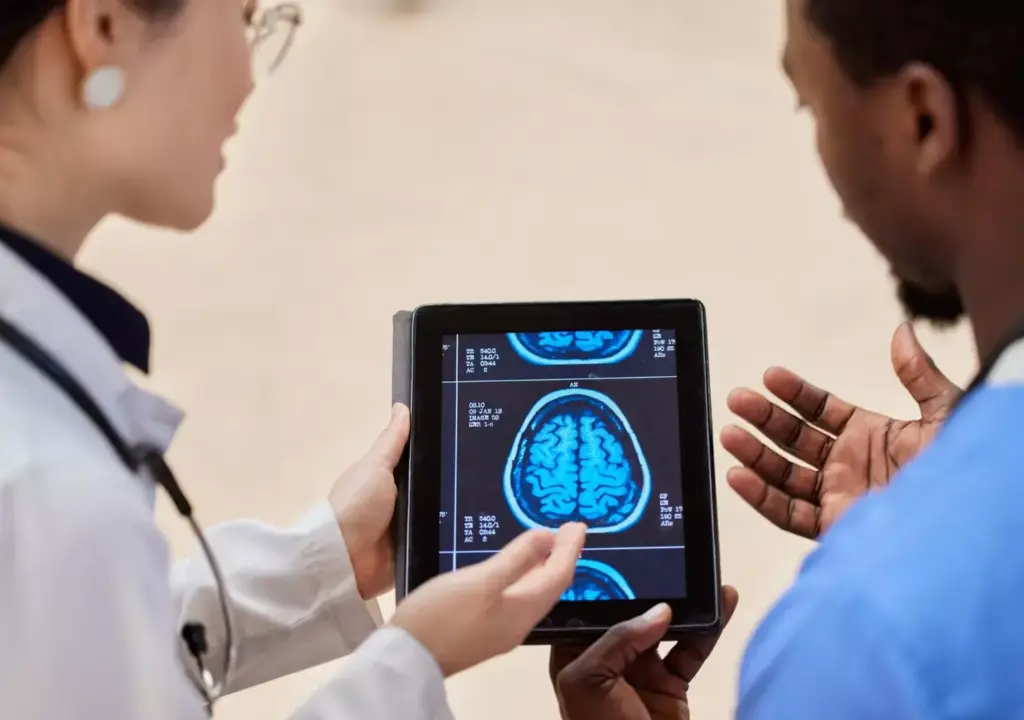Last Updated on November 26, 2025 by Bilal Hasdemir

Advances in brain tumor medication have greatly improved treatment results. This brings new hope to those dealing with this complex condition. At Liv Hospital, we focus on delivering top-notch care that puts the patient first. We aim to improve their quality of life during treatment.
Recent studies highlight the need for new medical solutions. They show how these can boost survival rates and treatment success. Our team is all about giving our patients the latest brain cancer drugs and therapies. We make sure they get the best care possible.
Finding your way through brain tumor medicine can feel overwhelming. That’s why we’re here to support you every step of the way. We help from the moment you’re diagnosed, through treatment, and even after.
Key Takeaways
- Innovative medications are improving survival rates for brain tumor patients.
- Liv Hospital offers patient-centered care and cutting-edge treatment options.
- Quality of life is a priority during cancer treatment.
- Advanced brain cancer drugs are boosting treatment success.
- Personalized care pathways are key for effective brain tumor treatment.
Understanding Brain Tumors and Current Treatment Landscape
It’s important to know about brain tumors to find good treatments. Brain tumors can be benign or malignant. They are hard to treat because of where they are and how they affect the brain.
Types of Brain Tumors and Their Characteristics
Brain tumors are divided into primary and metastatic types. Primary tumors include gliomas, meningiomas, and acoustic neuromas. Gliomas, like glioblastoma, vary in how aggressive they are and how well they respond to treatment.
We will look at what makes each tumor unique and how it affects treatment.
| Tumor Type | Characteristics | Common Treatments |
|---|---|---|
| Glioblastoma | Aggressive, highly malignant | Surgery, Temozolomide, Radiation |
| Meningioma | Typically benign, slow-growing | Surgery, Observation |
| Oligodendroglioma | Variable aggressiveness, often slow-growing | Surgery, Chemotherapy, Radiation |
The Evolution of Brain Tumor Pharmacotherapy
Brain tumor treatment has changed a lot with new drugs and methods. These advancements have made treatments more effective and less harmful.
Key Developments:
- Targeted therapies for specific genetic mutations
- Immunotherapies to boost the immune response against tumors
- Improved drug delivery systems to enhance blood-brain barrier penetration
Treatment Goals and Outcome Measures
Good treatment for brain tumors needs clear goals and ways to measure success. Goals include increasing survival, shrinking tumors, easing symptoms, and keeping quality of life good.
We check if treatment works by looking at how long patients live without their tumor getting worse. We also look at how long patients survive and how they feel about their treatment.
Vorasidenib: Revolutionary Treatment for IDH-Mutated Gliomas
Vorasidenib is a big step forward in treating IDH-mutated gliomas. It gives hope to those with this tough condition. IDH-mutated gliomas are brain tumors caused by IDH gene mutations. These tumors are hard to treat because of their location and genetic makeup.
Mechanism of Action and Blood-Brain Barrier Penetration
Vorasidenib works by stopping mutated IDH enzymes. It gets past the blood-brain barrier to reach the tumor. This is key because it lets the treatment work directly on the tumor cells.
Clinical Evidence for Extended Progression-Free Survival
Studies show Vorasidenib helps patients with IDH-mutated gliomas live longer without their tumors getting worse. The results are promising, showing Vorasidenib can make a big difference in patient care. It not only helps patients live better but also gives doctors more time to find other treatments.
Research on amivantamab also shows it improves patients’ quality of life. This highlights the need for new treatments for complex conditions like IDH-mutated gliomas.
Patient Selection and Genetic Testing Requirements
Vorasidenib works best for certain patients based on their tumor’s genetics. Genetic testing is key to finding the right candidates. It helps doctors see if a patient’s tumor has the IDH mutations needed for Vorasidenib treatment.
In summary, Vorasidenib is a game-changer for treating IDH-mutated gliomas. Its targeted approach, ability to cross the blood-brain barrier, and proven results make it a valuable tool. As we keep pushing forward in neuro-oncology, treatments like Vorasidenib help us better care for patients with brain tumors.
Temozolomide: Gold Standard for Glioblastoma Treatment
Temozolomide is a key treatment for glioblastoma, a fast-growing brain cancer. It’s known for helping patients live longer.
Targeting Rapidly Dividing Cancer Cells
Temozolomide attacks cancer cells that grow quickly. It stops tumors from getting bigger. This happens because it damages the DNA of cancer cells, stopping them from making copies.
Key benefits of Temozolomide include:
- Effective in treating glioblastoma
- Ability to cross the blood-brain barrier
- Well-tolerated by most patients
Stupp Protocol and Treatment Schedules
The Stupp Protocol combines Temozolomide with radiation therapy. It has greatly improved survival rates for glioblastoma patients.
The typical treatment schedule involves:
- Concurrent radiation therapy and Temozolomide
- Adjuvant Temozolomide cycles post-radiation
MGMT Methylation Status and Treatment Response
The MGMT methylation status is very important for Temozolomide treatment. Patients with MGMT promoter methylation tend to do better and live longer.
MGMT methylation status can:
- Predict treatment response
- Influence overall survival rates
- Guide personalized treatment decisions
Bevacizumab (Avastin): Targeting Tumor Vasculature
Bevacizumab (Avastin) is a key treatment for brain tumors. It works by blocking the growth of new blood vessels in tumors. This is because it targets vascular endothelial growth factor (VEGF), a key player in making new blood vessels.
Anti-Angiogenic Mechanism and Clinical Applications
Bevacizumab stops tumors from getting the blood they need to grow. It does this by blocking VEGF from binding to its receptor. This stops new blood vessels from forming, which is vital for tumor growth.
Studies have shown Bevacizumab is very effective. It has improved survival rates in patients with glioblastoma, a type of brain tumor. It has also helped patients live longer without their tumors getting worse.
Effectiveness in Reducing Peritumoral Edema
Bevacizumab is also great at reducing swelling around brain tumors. This swelling, called peritumoral edema, can put pressure on the brain. By reducing this swelling, Bevacizumab can help improve brain function.
It has also been shown to lower the need for steroids in patients. Steroids can have side effects, so this is a big plus.
Response Assessment Challenges and Pseudo-progression
Even though Bevacizumab is promising, figuring out how well it’s working can be tricky. Sometimes, it looks like the tumor is getting worse on scans, but it’s actually responding to treatment. This is called pseudo-progression.
To get a clear picture of how well the treatment is working, doctors use special imaging techniques. These include perfusion-weighted MRI and diffusion-weighted imaging. They help tell the difference between real tumor growth and pseudo-progression.
| Aspect | Description | Clinical Implication |
|---|---|---|
| Mechanism of Action | Inhibition of VEGF, preventing angiogenesis | Reduced tumor growth and metastasis |
| Clinical Application | Used in recurrent glioblastoma and other brain tumors | Improved progression-free survival |
| Effect on Edema | Reduces peritumoral edema | Decreased intracranial pressure, improved neurological function |
MT-125: Innovative Therapy for Enhanced Treatment Sensitivity
MT-125 is a new hope for those with brain tumors. It’s a groundbreaking therapy that could change how we treat brain cancer. This therapy might make treatments work better for patients.
Novel Mechanism for Overcoming Treatment Resistance
MT-125 targets the reasons why brain tumors resist treatment. It blocks the ways cancer cells avoid treatment. This could make old treatments work again.
Early tests show MT-125 makes brain tumor cells more sensitive to chemotherapy and radiation. This means these treatments could be more effective.
Synergistic Effects with Standard Chemotherapy and Radiation
MT-125 works well with standard treatments like chemotherapy and radiation. It makes tumor cells more sensitive to these treatments. This could lead to better outcomes for patients.
Our studies show MT-125 with temozolomide, a common chemotherapy, can improve treatment results and survival rates.
Current Clinical Trials and Preliminary Results
MT-125 is being tested in clinical trials to see if it’s safe and effective. Early results are promising, with some patients seeing their tumors shrink and feeling better.
We’re hopeful MT-125 could be a game-changer for brain tumor treatment. We’re excited to keep researching and exploring its possibilities.
Lomustine (CCNU): Effective Alkylating Agent for Recurrent Tumors
Lomustine is a key drug in fighting recurrent brain tumors. It’s used in many treatment plans because it works well against some brain cancers.
Mechanism of Action and Tumor Cell Targeting
Lomustine attaches an alkyl group to cancer cells’ DNA. This stops them from copying themselves and kills them. It’s great for killing fast-growing tumor cells.
Lomustine can get past the blood-brain barrier. This is key for treating brain tumors because it lets it reach and kill tumor cells in the brain.
Role in PCV Combination Therapy for Oligodendrogliomas
Lomustine is a big part of the PCV therapy. This includes Procarbazine and Vincristine. It’s very good at treating oligodendrogliomas, a type of glioma.
| Therapy Component | Mechanism of Action | Role in PCV |
|---|---|---|
| Lomustine (CCNU) | Alkylating agent | Damages DNA of cancer cells |
| Procarbazine | Alkylating agent | Further damages DNA, synergistic effect |
| Vincristine | Mitotic inhibitor | Disrupts cell division |
Monitoring and Managing Hematologic Toxicity
Lomustine can cause problems with blood cells. We watch patients’ blood counts closely to manage this risk.
We adjust Lomustine doses based on blood counts and health. Regular blood tests help catch any problems early.
By managing treatment and watching for side effects, we can make Lomustine work better. And we can reduce its risks.
Carmustine (BCNU): Wafer Implants for Direct Tumor Treatment
Implantable Carmustine wafers are changing brain tumor therapy. They deliver chemotherapy right to the tumor. This method is promising, mainly for certain brain tumors, when used with other treatments.
Gliadel Wafer Technology and Surgical Implementation
The Gliadel wafer is made of a biodegradable polymer with Carmustine, a chemotherapy drug. During surgery, these wafers are placed in the tumor cavity after removal. As they dissolve, they release Carmustine, giving a steady dose of chemotherapy to the area.
Key benefits of Gliadel wafer technology include:
- Direct delivery of chemotherapy to the tumor site
- Minimized systemic side effects
- Potential for improved local control of tumor growth
Local Drug Delivery Advantages and Limitations
Gliadel wafers deliver Carmustine directly to the tumor. This means higher drug levels locally and fewer side effects systemically. It’s a better way to fight tumors.
But, there are downsides. The success of Gliadel wafers depends on how much tumor is removed and if there’s any left. Also, like any surgery, there are risks with implanting these wafers.
Patient Selection for Implantable Chemotherapy
Not every brain tumor patient is right for Gliadel wafer implants. They’re best for those with high-grade gliomas after surgery. Doctors choose who gets them based on the tumor type, size, and location, and the patient’s health and past treatments.
We think Carmustine wafer implants are a good option for some brain tumor patients. They offer a targeted and steady chemotherapy dose. This could lead to better results for some patients.
Targeted Meds for Brain Tumor: Precision Medicine Approaches
The treatment of brain tumors is changing with new targeted therapies. We now understand the genetic makeup of brain tumors better. This knowledge helps us create treatments that target each tumor’s unique traits.
Molecular Profiling and Biomarker-Driven Treatment
Molecular profiling is key in treating brain tumors. It helps us find specific genetic changes or biomarkers. This way, we can tailor treatments to match each patient’s tumor.
Advanced genetic tests help find these changes. Biomarkers like IDH, BRAF, and MGMT status are important. Knowing these details lets us choose the best treatments for each tumor.
BRAF Inhibitors for BRAF-Mutated Tumors
BRAF mutations are found in some brain tumors. BRAF inhibitors are promising treatments for these tumors. They target the BRAF protein, which helps tumors grow.
Studies show BRAF inhibitors can shrink tumors and improve survival. Drugs like vemurafenib and dabrafenib are used alone or with MEK inhibitors. This combination boosts their effectiveness.
- Key benefits of BRAF inhibitors:
- Targeted action against BRAF-mutated tumor cells
- Potential for improved treatment response
- Combination therapy options to overcome resistance
NTRK Inhibitors and Emerging Targeted Therapies
NTRK gene fusions are another target for brain tumors. NTRK inhibitors like larotrectinib and entrectinib work well on NTRK-positive tumors. This includes tumors in the brain.
Other targeted therapies are being studied too. They target different pathways that help tumors grow. Ongoing research and trials are finding new targets and treatments. This gives hope for better outcomes for brain tumor patients.
As precision medicine advances, targeted therapies will become more important. Tailoring treatments to each tumor’s molecular profile will lead to more effective care. This is a step towards more personalized treatment for our patients.
Corticosteroids: Essential Supportive Medications
Corticosteroids, like dexamethasone, are key in caring for brain tumor patients. They help manage swelling in the brain. This makes patients feel better and live better lives.
Dexamethasone for Managing Cerebral Edema
Dexamethasone is a top choice for brain tumor care. It fights inflammation well and has less effect on minerals. It helps reduce swelling around tumors, easing headaches, nausea, and other symptoms.
“Corticosteroids like dexamethasone have changed how we treat brain swelling,” a leading neuro-oncologist. “They quickly reduce swelling and ease symptoms, making them a vital part of our treatment.”
Optimal Dosing Strategies and Tapering Protocols
The right dose of dexamethasone depends on each patient. A high dose is first used to quickly ease symptoms. Then, the dose is slowly lowered to the least needed amount to avoid side effects.
- Initial dose: 8-16 mg/day
- Maintenance dose: 2-4 mg/day
- Tapering schedule: Gradually reduce the dose every 2-3 days
Balancing Symptom Control with Side Effect Management
Corticosteroids are great at managing swelling but can cause problems like bone loss, diabetes, and weakened immune system. It’s important to weigh the good against the bad.
Key strategies for minimizing side effects include:
- Using the lowest effective dose of dexamethasone
- Implementing a tapering protocol as soon as symptoms are controlled
- Monitoring patients for possible side effects
By using these strategies, we can make the most of corticosteroids. This helps improve the care of brain tumor patients.
Immunotherapy Frontiers in Brain Tumor Treatment
Immunotherapy is a new way to fight brain tumors. It uses the body’s immune system to attack cancer cells. As we learn more about how the immune system works with brain tumors, we find new ways to treat them.
Checkpoint Inhibitors and Their Application in CNS Tumors
Checkpoint inhibitors have changed how we treat cancer. They help the immune system fight cancer cells better. In brain tumors, they might help treat tumors in the central nervous system (CNS).
The promise of checkpoint inhibitors lies in their ability to enhance the body’s natural immune response against cancer cells.
Scientists are studying checkpoint inhibitors for brain tumors. They want to see how well they work and if they are safe. The aim is to find the best way to use these therapies to help patients.
Vaccine Therapies and Personalized Immunological Approaches
Vaccine therapies are another exciting area in fighting brain tumors. These vaccines help the immune system find and attack cancer cells. Personalized vaccine approaches are being made. They are tailored to fit each patient’s tumor.
This personalized method could lead to better treatments and longer lives for patients. By focusing on each tumor’s unique traits, vaccines might be more effective.
Strategies for Enhancing Immune Response in the CNS
It’s important to boost the immune response in the CNS to treat brain tumors. The blood-brain barrier makes it hard to get treatments to brain tumors. Researchers are working on new drugs and ways to get treatments past this barrier.
Combination therapies are also being looked into. They mix checkpoint inhibitors, vaccine therapies, or other treatments with surgery, chemotherapy, and radiation. The goal is to make treatments work better together.
Advanced Treatment Protocols at Specialized Centers Like Liv Hospital
At Liv Hospital, we lead in advanced brain tumor treatments. We use the latest technology and care deeply for our patients. Our team works together to give each patient a treatment plan that fits them best.
Multidisciplinary Approach to Brain Tumor Management
Our team includes experts like neurosurgeons and oncologists. They work together to create treatment plans for brain tumor patients. This teamwork helps us meet the complex needs of our patients.
We use top-notch tools to diagnose and stage brain tumors. This is key for choosing the right treatment.
Implementation of Cutting-Edge Medical Protocols
Liv Hospital is always looking for new ways to treat brain tumors. We use the latest in targeted and immunotherapies, and advanced surgery. Our goal is to use the best technology and treatments.
Our commitment to new medicine shows in our use of advanced technology and proven treatments.
Patient-Centered Care Pathways and Quality Metrics
We focus on patient care, making plans that meet each person’s needs. We also check our quality to ensure top care for all patients.
Here’s a look at our patient-centered care:
| Care Pathway Component | Description | Quality Metric |
|---|---|---|
| Initial Consultation | Comprehensive assessment by our multidisciplinary team | Patient satisfaction score |
| Treatment Planning | Personalized treatment plan development | Time-to-treatment initiation |
| Ongoing Care | Continuous monitoring and support throughout treatment | Symptom management effectiveness |
Liv Hospital combines the latest medical protocols with care that focuses on the patient. Our goal is to provide top-notch, caring care for brain tumor patients.
Conclusion: Navigating the Complex Landscape of Brain Tumor Treatments
Exploring brain tumor treatments shows us that a mix of approaches is key. New medicines have made a big difference, giving hope to those affected.
We’ve looked at different medicines like Vorasidenib for certain gliomas, Temozolomide for glioblastoma, and Bevacizumab for tumors. These, along with supportive care, make up a full treatment plan.
Hospitals like Liv Hospital are essential in using the latest treatments and caring for patients. They help doctors create plans that work best for each patient.
The field of brain tumor treatments is always changing. This means we need to keep researching and finding new medicines. We’re dedicated to giving top-notch care to patients from around the world.
FAQ
What are the most common types of brain tumors?
Common brain tumors include gliomas, meningiomas, and acoustic neuromas. Gliomas are divided into astrocytomas, oligodendrogliomas, and ependymomas. Glioblastoma is the most aggressive type.
How do brain tumor medications work?
Medications for brain tumors use different methods. Chemotherapy targets fast-growing cancer cells. Targeted therapies, like Vorasidenib, focus on specific genetic mutations.
What is the role of MGMT methylation status in glioblastoma treatment?
MGMT methylation status is key in treating glioblastoma. Patients with MGMT promoter methylation do better with Temozolomide. This is because methylation silences the MGMT gene, making the tumor more treatable.
How does Bevacizumab work in brain tumor treatment?
Bevacizumab targets vascular endothelial growth factor (VEGF). It stops new blood vessels from forming, which helps reduce tumor growth and swelling.
What are the benefits and limitations of local drug delivery with Carmustine wafers?
Carmustine wafers (Gliadel) deliver chemotherapy directly to the tumor site during surgery. This method has high local concentrations and fewer side effects. But, it’s only for patients who can have surgery, and not all tumors or locations are suitable.
How do corticosteroids like Dexamethasone help manage brain tumor symptoms?
Corticosteroids like Dexamethasone help with swelling and symptoms like headaches. They reduce inflammation and swelling, improving comfort and quality of life.
What is the current status of immunotherapy in brain tumor treatment?
Immunotherapy is a growing area in brain tumor treatment. Checkpoint inhibitors and vaccine therapies are being studied. But, brain tumors’ immune suppressive environment is a challenge. Research is ongoing to improve immune response and treatment results.
How are targeted therapies selected for brain tumor patients?
Targeted therapies are chosen based on the tumor’s molecular profile. This identifies genetic mutations or biomarkers that drive tumor growth. This information helps pick the right therapy, like BRAF inhibitors for BRAF-mutated tumors.
What are the advantages of treatment at specialized centers like Liv Hospital?
Centers like Liv Hospital offer a team approach to brain tumor care. They use the latest medical protocols and tools. This ensures patients get the best and most personalized treatment.
Are there any new medications or therapies on the horizon for brain tumor treatment?
Yes, new treatments are being explored, including targeted therapies and immunotherapies. Clinical trials are underway to improve treatment results and offer more options for patients.








